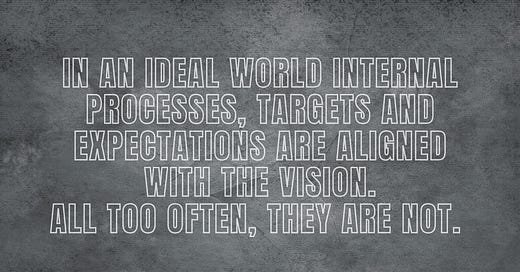Vision: Don't Make it an Empty Statement - it has a Role in Everyday Management
Let me show you how proper vision statements can Guide Decision-Making in Uncertain and Difficult times
I’ve written a few vision and mission statements in my life and helped others write their own. Many times I coaxed out of executives what they really wanted and what they believed in.
If you’ve never been through this exercise, defining a useful vision statement, it is harder than it sounds. Important though.
Still, I cannot escape the feeling that most of these statements end up becoming pretty, admirable sentiments to be put on websites and recruitment brochures and don’t quite translate to the day-to-day of doing business. Even though that is exactly what they are supposed to be about: driving the way the business operates internally and conducts itself externally.
Sentiments and intentions matter, of course, but what do you really do day to day? Because that’s what really matters.
It is when establishing and implementing internal processes and when making big-impact business decisions that vision, mission and values should be there, both to guide you and to highlight any tension between the ideal and the real.
Perhaps sometimes what you need to do as a CEO in the interest of the company’s future is in conflict with what you, as a person, with a family, with a private life, want to do.
Maybe you are a department head or a team leader, and what you feel you should be doing conflicts with the organisation’s processes or stated plans.
The truly difficult decisions are those that present a unique tension between the why and how you want to conduct business - and the reality of the situation.
There are instances when the interests of different external players conflict. At the top of the organisation, you need to protect the interests of the “company”. But there are many other interests to consider. That of its people. And its wider ecosystem, such as loyal customers. Your biggest supplier. And yourself.
How often do you reach back to the vision, mission, purpose or value statement of your organisation before making decisions on the back of these tensions?
Be honest.
Most of us neglect to do this, and instead, we agonise internally without much guidance or guardrails. Because all too often, vision and value statements, as lofty as they are, were not crafted to provide us guidance in the everyday of working. They were crafted to be pretty.
We talk about the North Star, but, be honest, how often have you measured your decisions against it? Most likely, you were aligning your decisions with the performance targets and incentives in place.
In an ideal world, internal processes, targets and expectations would be aligned with the vision. All too often, they are not.
Let’s look at what it means in practice, with some examples of how critical decision-making is impacted.
I really appreciated what



